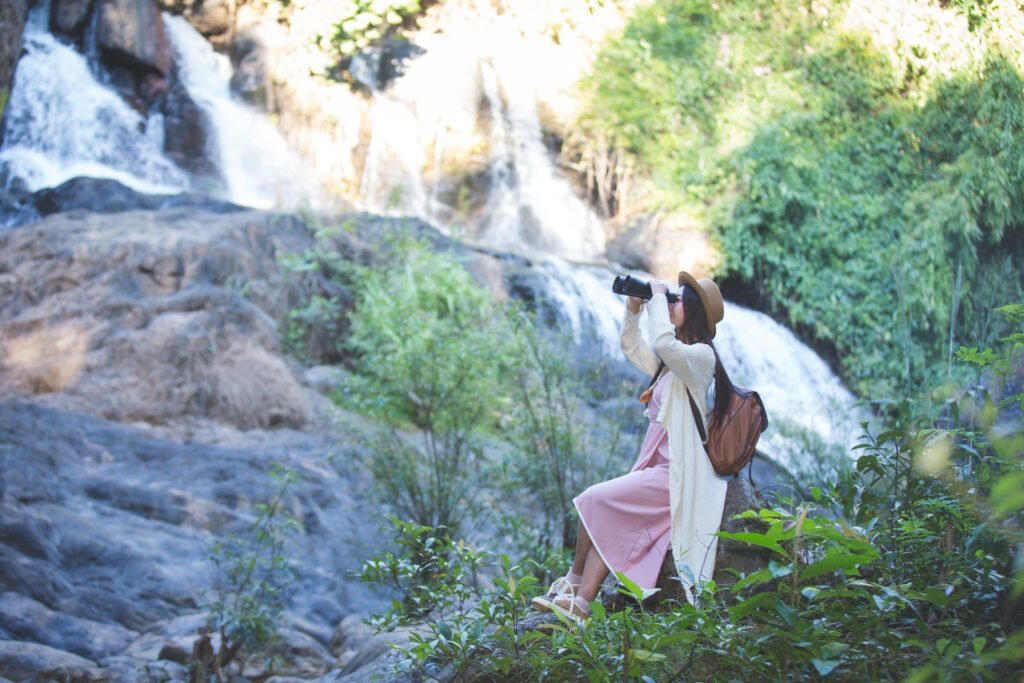Nestled amid mist-shrouded mountains and lush valleys, Chiang Mai is a visual symphony where ancient traditions harmonize with vibrant modern life. As the cultural heart of northern Thailand, it offers a kaleidoscope of photographic opportunities—from gilded temples piercing the sky to bustling night markets awash in neon hues. This article explores the iconic and hidden gems that make Chiang Mai a photographer’s paradise, guiding you through the stories behind each frame and the techniques to immortalize its magic. Whether you’re an amateur with a smartphone or a seasoned pro, these visuals will ignite your wanderlust and deepen your connection to the “Rose of the North.”
1. Temples: Where Spirituality Meets Architecture
Capture the ethereal beauty of sacred spaces.
Chiang Mai’s skyline is punctuated by over 300 temples (wats), each narrating centuries of Lanna heritage. Wat Phra That Doi Suthep, perched atop a mountain, offers panoramic city vistas and intricate golden chedis (stupas) glowing at sunrise. Wat Chedi Luang, with its partially ruined 15th-century stupa, contrasts ancient grandeur with serene Buddha statues draped in saffron cloth. For intimate shots, Wat Umong’s moss-covered tunnels and forested grounds evoke mystery. Tip: Visit at dawn to avoid crowds and capture soft light filtering through incense smoke. Use wide-angle lenses for architecture and macro settings for details like carved naga serpents or offerings of marigolds.
2. Nature: Mountains, Waterfalls, and Wild Horizons
Frame the untamed landscapes beyond the city.
Beyond urban charms, Chiang Mai’s hinterlands are a playground for nature photographers. Doi Inthanon National Park, Thailand’s highest peak, enchants with cloud forests, cascading waterfalls (like Wachirathan), and terraced rice fields. The Mae Kampong Village reveals emerald tea plantations and wooden huts clinging to hillsides. At Huay Tung Tao Reservoir, still waters mirror the surrounding mountains, perfect for reflection shots. Tip: Hike trails early to photograph mist rolling over valleys. Use polarizing filters to enhance skies and water, and a telephoto lens to isolate wildlife like gibbons or exotic birds.
3. Street Life: Markets, Murals, and Midnight Energy
Document the pulse of everyday enchantment.
Chiang Mai’s streets buzz with kinetic energy. The Sunday Night Market transforms the Old City into a tapestry of lantern-lit stalls, sizzling street food, and artisans crafting silver jewelry. Warorot Market bursts with color: pyramids of tropical fruit, bundles of spices, and vendors in hill-tribe attire. Hidden alleys in the Nimmanhaemin district showcase vibrant street art, blending modern graffiti with traditional motifs. Tip: Shoot in burst mode to capture dynamic crowd scenes. For food photography, use a fast prime lens (f/1.8) under low light, and focus on textures—steam rising from khao soi bowls or glistening mango sticky rice.
4. Festivals: Fire, Light, and Cultural Spectacles
Freeze moments of collective celebration.
Chiang Mai’s festivals are visual feasts. Yi Peng (November) fills the sky with thousands of glowing lanterns, creating an ethereal ballet of light against the night. Songkran (April) turns streets into water-fight battlegrounds, where candid shots of laughter and drenched revelers abound. Boi Sang Umbrella Festival (January) highlights hand-painted parasols drying in the sun—a rainbow of artisan craftsmanship. Tip: For Yi Peng, use a tripod and long exposure (10–30 sec) to trail lantern paths. During Songkran, protect your gear with waterproof covers and focus on expressive portraits.
5. Hill Tribes: Portraits of Resilience and Tradition
Honor the human stories behind the lens.
The mountains surrounding Chiang Mai are home to indigenous communities like the Karen, Hmong, and Akha. Their vibrant textiles, silver jewelry, and agrarian lifestyles offer profound portrait opportunities. Doi Pui Village and Mae Jam provide ethical access to photograph artisans weaving or farmers tending fields. Tip: Always ask permission before taking portraits. Use natural light to highlight weathered faces and intricate costumes. A shallow depth of field (e.g., f/2.8) draws focus to subjects while softening lush backdrops.
Conclusion: The Eternal Frame
Chiang Mai isn’t merely a destination; it’s a living gallery where every snapshot tells a story of resilience, spirituality, and joy. From the golden spires of wats to the neon pulse of night markets, its visuals linger long after the journey ends. As you compose your frames, remember that the best photographs emerge not just from technical skill, but from patience and respect—waiting for the monk’s quiet stride at dawn, sharing a smile with a market vendor, or honoring the stillness of a mountain vista. In capturing Chiang Mai, you immortalize a dialogue between past and present, nature and humanity.
FAQ: Mastering Chiang Mai Photography
Q1: When is the best time for photography in Chiang Mai?
A: November–February offers cool, clear skies ideal for landscapes. March–April captures festivals but has haze. Rainy season (July–October) brings lush greenery and dramatic clouds.
Q2: Are drones allowed?
A: Strict regulations apply. Avoid flying near temples, airports, or national parks without permits. Use apps like AirMap to check restrictions.
Q3: How to photograph temples respectfully?
A: Dress modestly (cover shoulders/knees), remove shoes indoors, and avoid pointing lenses directly at worshippers. Silent shutters recommended.
Q4: Best gear for low-light markets?
A: A fast lens (e.g., 35mm f/1.4) and mirrorless camera with high ISO performance. A lightweight tripod helps for long exposures.
Q5: Ethical tips for hill-tribe photography?
A: Book tours through community-based initiatives (e.g., MAP Foundation). Offer small payments for portraits and avoid exploitative “human zoo” scenarios.
Q6: Must-try unique shots?
A:
-
Monks collecting alms at dawn (Thanon Suthep).
-
The “Sticky Waterfall” (Bua Tong) with turquoise cascades.
-
Silhouettes of hot air balloons at sunrise (Winter only).


